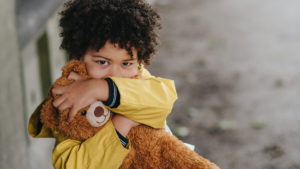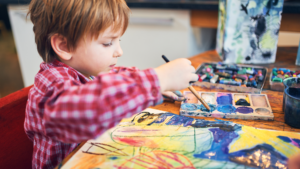Calming First Day Nerves

Starting kindergarten is a huge step in your child’s life.
It’s often the first time they’re setting off on their own, and the beginning of many years of formal education to come. Giving tamariki the best introduction to learning outside the home can bring positive benefits that they will take with them into a lifetime of learning, so, it’s good to get it right from the start.
Kidsfirst Cotswold Ave teacher, Zoe McFadden, says making visits to the kindy are a must.
“We encourage pre-visits so we can take time to show tamariki and whānau around the kindergarten, understand their interests, and get them familiar with routines. They learn where their bag goes, and have the chance to explore the playground and meet the kaiako. This helps create a sense of predictability, so they know what to expect on their first day.”
There can be a lot to learn and remember for tamariki and their whānau, but Kidsfirst’s teaching teams make it as easy as possible to get into the swing of things.
“We provide families with the information about the kindergarten and make sure they’re aware of any trips planned, and activities their child may want to take part in. It’s just as important for whānau to get to know the kindergarten and routines as it is for tamariki,” Zoe says.
There’s no limit to the number of visits tamariki and whānau can make, while they learn more about life at kindergarten and get an idea of what it will be like for them.
“As teachers, we know that sensitivity and openness are important,” says Zoe. “We understand that some families may need some extra visits and always encourage whānau to let us know if they feel they need more time.”
Zoe says visits help kaiako to get to know tamariki, just as much as helping whānau and tamariki get to know them.
“It provides us with an opportunity to talk to the child and whānau about what to expect, speak positively about how fun kindergarten will be, and all the friends they’re going to make.”
Kidsfirst Terrace Head Teacher, Kristen Ojala, says this is a crucial stage in helping both tamariki and whānau get ready, and there are things to do at home that can help, too. Having positive conversations about kindergarten and involving tamariki in preparing for their first day can help reduce any anxieties.
“It helps to have lots of conversations at home about kindergarten, what it’s like and what happens there. Reassure tamariki that they will be picked up at the end of the day, and make sure to include them in fun activities like buying new lunch boxes and packing them together.”
Zoe McFadden agrees that getting tamariki involved in the preparations is a good way to settle any nerves.
“It’s important for parents to understand their child might be nervous – it’s a big change. Predictability can help – whānau might start a new routine so things begin to feel familiar. That could include packing bags in the morning and making it an exciting time to talk about how great kindergarten will be.”


Positive feedback can help to encourage tamariki to settle in once they’re feeling a bit safer. Zoe says the key is to tailor the transition to meet the needs of tamariki, and how they handle this important step isn’t always age related.
“It all depends on the experience of the child. A two-year-old may have already been in a nursery setting, which is a huge help because they have experienced the transition between learning spaces. In other cases, older children may have never been away from home before – so parents can usually determine the best way to help their child based on personality and experiences.”
Sometimes, it’s not tamariki who are nervous about the first days or weeks, rather it’s the whānau.
“We are always happy to keep in contact through texts and send photos to let them know how their child’s day is going. Whānau are always welcome to visit, too. As teachers, we are always there to give support and offer reassurance.”
If your tamariki is about to embark on their first day at kindergarten, here’s a recap of some of the top things our kaiako recommend to help make the transition as smooth as possible:
- Arrange a visit to the kindergarten: become familiar with the environment, the teachers and routines and regular events
- Establish strong routines at home: give your child the opportunity to help create the routines and involve them in getting ready each morning so there is a sense of predictability and familiarity
- Accentuate the positives: keep talking with your child about what it’s like to go to kindergarten, and make sure to keep it positive. Check in, and don’t be afraid to stay in touch – your teaching team would rather hear from you than have you wondering and worrying about them.

